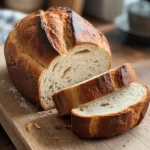I’ll share my Soft French Roll recipe that uses just a few pantry staples and a straightforward, foolproof method so you can bake it at home.

I still get a little giddy when Soft Fluffy French Bread is baking. The golden crust and airy, tender crumb always surprise me, like somehow a loaf turned into something better than I expected.
The scent of warm water and active dry yeast in the air will stop you, trust me. I love that it feels fancy but is actually pretty low fuss, and it’s perfect as a Soft French Roll for sandwiches or dunking into soup.
If you like easy wins that impress, this one will make you curious enough to try it, even on a weeknight.
Why I Like this Recipe
* I like that it’s really forgiving I mess up sometimes but it still turns out good
* I like that it makes enough to share so my friends and family always get some
* I like how it goes with almost anything so I don’t get tired of eating it
* I like that making it makes me feel proud like I actually accomplished something
Ingredients

- All purpose flour gives structure and lots of carbs, little fiber, mild flavor.
- Active dry yeast makes bread rise, adds slight tang and yeasty aroma.
- Sugar feeds yeast for rise, adds subtle sweetness, more makes it sweeter.
- Butter adds fat for softness, richer flavor, a little keeps crumb tender.
- Milk lends tenderness, some protein and sugar, browns crust and softens crumb.
- Salt boosts flavor, controls yeast activity, too much makes loaf salty.
- Egg wash gives glossy crust and a touch of protein, optional but nice.
- Warm water activates yeast, hydrates flour, affects texture, don’t use very hot.
Ingredient Quantities
- 1 1/4 cups warm water (about 110°F / 43°C not hot)
- 1/2 cup warm milk (about 110°F)
- 2 1/4 teaspoons (1 packet) active dry yeast
- 2 tablespoons granulated sugar
- 2 tablespoons unsalted butter melted and cooled
- 1 1/2 teaspoons salt
- 3 1/2 to 4 cups all purpose flour (420 to 480 g)
- 1 tablespoon vegetable oil for the bowl (optional)
- 1 egg beaten for egg wash (optional)
How to Make this
1. Stir warm water and warm milk (about 110°F / 43°C) in a large bowl, sprinkle the yeast and sugar over the top, give it a quick stir and let sit 5 to 10 minutes until foamy and bubbly.
2. Add the cooled melted butter and salt to the yeast mixture, stir to combine, then add about 2 cups of the flour and mix until it looks shaggy.
3. Gradually add the remaining 1 1/2 to 2 cups of flour, a little at a time, until the dough pulls away from the sides and is soft and slightly sticky but manageable.
4. Turn the dough onto a lightly floured surface and knead for about 8 to 10 minutes until smooth and elastic, or use a stand mixer with a dough hook for 5 to 7 minutes; avoid adding too much extra flour, you want a soft dough.
5. Lightly oil a bowl with the vegetable oil if using, place the dough seam side down, cover with a damp towel or plastic wrap, and let rise in a warm place about 1 hour or until doubled in size.
6. Punch the dough down, divide into two equal pieces, shape each into a long loaf or baguette by rolling and tucking the seams underneath, place on a parchment lined baking sheet, cover and let rise 30 to 45 minutes until puffy.
7. Preheat the oven to 375°F (190°C). If using the beaten egg for egg wash, lightly brush the tops for shine, then make 3 or 4 diagonal slashes across each loaf with a sharp knife.
8. Bake the loaves about 20 to 25 minutes until golden brown and they sound hollow when tapped, or the internal temperature reads about 190°F; if they brown too fast, tent loosely with foil.
9. Remove from the oven, brush with a little melted butter if you want a softer crust, let cool on a wire rack at least 15 minutes before slicing so the crumb sets, then enjoy warm with butter or soup.
Equipment Needed
1. Large mixing bowl, for proofing the yeast and mixing the dough
2. Measuring cups and measuring spoons, for water milk sugar flour etc
3. Instant read thermometer, to check about 110°F for liquids and ~190°F for doneness
4. Wooden spoon or sturdy rubber spatula, for stirring the shaggy dough
5. Stand mixer with dough hook (optional), or be ready to knead by hand for 8–10 minutes
6. Bench scraper, to divide the dough and keep the counter tidy
7. Parchment lined baking sheet, to bake the loaves on
8. Sharp serrated knife, for making the diagonal slashes before baking
9. Pastry brush and wire cooling rack, for egg wash or butter and to cool the loaves
FAQ
Soft Fluffy French Bread Recipe Substitutions and Variations
- Milk: swap the 1/2 cup warm dairy milk for 1/2 cup unsweetened soy or oat milk at the same temp; almond or light coconut milk work too but they can be thinner so you might need 1 to 2 tbsp more flour.
- Yeast: use instant (rapid) yeast 1:1 and mix it right into the dry ingredients, no proofing needed, or use fresh cake yeast at about 3 times the weight (roughly 21 g instead of one 7 g packet) dissolved in the warm liquids.
- Flour: substitute bread flour cup for cup for a chewier, taller loaf; start with 3 1/2 cups and add up to 4 cups only if the dough feels too sticky since bread flour absorbs differently.
- Butter: replace the 2 tbsp melted unsalted butter with 2 tbsp neutral oil like canola or light olive oil for equal tenderness, or use melted coconut oil if you want a subtle sweet note.
Pro Tips
1) Proof the yeast like a boss, but dont overthink it. If the mix isnt foamy in 10 minutes toss the yeast and start over. Use a thermometer if you got one, wrist test works too: it should feel warm not hot. Too hot kills the yeast, too cool and it will be sluggish.
2) Resist the urge to add more flour while kneading. A slightly tacky dough gives a softer crumb. If it feels unmanageable wet your hands or the bench with a little water or oil, or do a 10 minute rest after mixing so the flour hydrates then finish kneading. Weigh your flour when you can, cups lie.
3) Get good surface tension when shaping. Roll the loaf tight, tuck the seams under and use your knuckles to pull the dough along the bench so the top gets smooth. This helps oven spring and gives nice uniform holes. If the dough springs back quickly when poked, let it rest a few more minutes before shaping.
4) Make steam in the oven for the first 8 to 12 minutes to boost oven spring and get a glossy crust. Put a small pan of boiling water or a few ice cubes on the bottom rack, or spray the oven walls once you slide the loaves in. If the crust browns too fast tent with foil, and brush warm loaves with melted butter right out of the oven for a softer crust.

Soft Fluffy French Bread Recipe
I’ll share my Soft French Roll recipe that uses just a few pantry staples and a straightforward, foolproof method so you can bake it at home.
12
servings
169
kcal
Equipment: 1. Large mixing bowl, for proofing the yeast and mixing the dough
2. Measuring cups and measuring spoons, for water milk sugar flour etc
3. Instant read thermometer, to check about 110°F for liquids and ~190°F for doneness
4. Wooden spoon or sturdy rubber spatula, for stirring the shaggy dough
5. Stand mixer with dough hook (optional), or be ready to knead by hand for 8–10 minutes
6. Bench scraper, to divide the dough and keep the counter tidy
7. Parchment lined baking sheet, to bake the loaves on
8. Sharp serrated knife, for making the diagonal slashes before baking
9. Pastry brush and wire cooling rack, for egg wash or butter and to cool the loaves
Ingredients
-
1 1/4 cups warm water (about 110°F / 43°C not hot)
-
1/2 cup warm milk (about 110°F)
-
2 1/4 teaspoons (1 packet) active dry yeast
-
2 tablespoons granulated sugar
-
2 tablespoons unsalted butter melted and cooled
-
1 1/2 teaspoons salt
-
3 1/2 to 4 cups all purpose flour (420 to 480 g)
-
1 tablespoon vegetable oil for the bowl (optional)
-
1 egg beaten for egg wash (optional)
Directions
- Stir warm water and warm milk (about 110°F / 43°C) in a large bowl, sprinkle the yeast and sugar over the top, give it a quick stir and let sit 5 to 10 minutes until foamy and bubbly.
- Add the cooled melted butter and salt to the yeast mixture, stir to combine, then add about 2 cups of the flour and mix until it looks shaggy.
- Gradually add the remaining 1 1/2 to 2 cups of flour, a little at a time, until the dough pulls away from the sides and is soft and slightly sticky but manageable.
- Turn the dough onto a lightly floured surface and knead for about 8 to 10 minutes until smooth and elastic, or use a stand mixer with a dough hook for 5 to 7 minutes; avoid adding too much extra flour, you want a soft dough.
- Lightly oil a bowl with the vegetable oil if using, place the dough seam side down, cover with a damp towel or plastic wrap, and let rise in a warm place about 1 hour or until doubled in size.
- Punch the dough down, divide into two equal pieces, shape each into a long loaf or baguette by rolling and tucking the seams underneath, place on a parchment lined baking sheet, cover and let rise 30 to 45 minutes until puffy.
- Preheat the oven to 375°F (190°C). If using the beaten egg for egg wash, lightly brush the tops for shine, then make 3 or 4 diagonal slashes across each loaf with a sharp knife.
- Bake the loaves about 20 to 25 minutes until golden brown and they sound hollow when tapped, or the internal temperature reads about 190°F; if they brown too fast, tent loosely with foil.
- Remove from the oven, brush with a little melted butter if you want a softer crust, let cool on a wire rack at least 15 minutes before slicing so the crumb sets, then enjoy warm with butter or soup.
Notes
- Below you’ll find my best estimate of this recipe’s nutrition facts. Treat the numbers as a guide rather than a rule—great food should nourish both body and spirit. Figures are approximate, and the website owner assumes no liability for any inaccuracies in this recipe.
Nutrition Facts
- Serving Size: 78g
- Total number of serves: 12
- Calories: 169kcal
- Fat: 2.8g
- Saturated Fat: 1.1g
- Trans Fat: 0.02g
- Polyunsaturated: 0.07g
- Monounsaturated: 0.43g
- Cholesterol: 5.4mg
- Sodium: 291mg
- Potassium: 67mg
- Carbohydrates: 30.6g
- Fiber: 1g
- Sugar: 2.1g
- Protein: 4.2g
- Vitamin A: 42IU
- Vitamin C: 0mg
- Calcium: 16mg
- Iron: 1.4mg
















